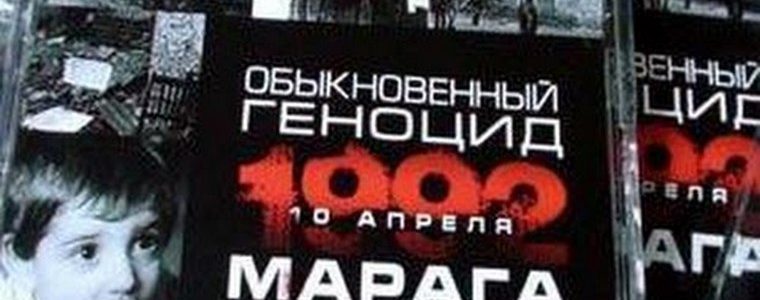“The name of this village is connected with a massacre that the world media don’t write about.” This sentence comes from the book “Ethnic Cleansing in Progress: War in Nagorno Karabakh” published in 2001. It was authored by cross-bench member of the House of Lords of the UK Baroness Caroline Cox and CEO of the Christian Solidarity International John Eibner.
“This village is Maraga.” (marked as “Leninavan” on some Soviet-time maps: this was the name of two united villages – Maragi and Margushevan in the Mardakert region of the Nagorno-Karabakh Republic). The tragedy of Maraga hasn’t been covered in the world press. And in Armenian press, Maraga is only remembered in connection with the anniversary of that terrible day – April 10, 1992.
Meanwhile, on that day, in the early spring morning, a terrible tragedy occurred, the horrific details of which still chill the soul. More than 50 people were brutally massacred – many were murdered in their beds, some were crushed by tanks, the rest were beheaded or burned alive. More than 50 were taken hostage, of which 19 still remain missing.
A few days after the events, the remains of the victims were exhumed with the active participation of Baroness Cox. The world received material evidence of the terrible crime of Azerbaijan. But the international community did not shudder, did not condemn the criminals, did not punish them. The events of Maraga would never be covered in the world press.
In 2001 was the 50th anniversary of the adoption of the Genocide Convention by the UN. The 10th anniversary of Operation Ring was in 2001 as well. In 1998 was also the 10th anniversary of the Sumgait pogroms. Lastly, the 21st century began for us with the 10th anniversary of the Baku pogroms.
Maraga is just one among the massacres of Armenians committed by the Azerbaijanis in the 1990s. It was the least covered yet one of the most brutal pogroms of Armenians in the decade.
Despite the best efforts of Artsakh, Maraga massacre was not properly presented to the wider international community as an act of vandalism and did not receive not only any assessment but even a simple sympathy.
Even international organizations that specialized in helping victims of this kind haven’t paid attention to the people of Maraga. According to generally accepted standards, they had to provide material, moral, and medical relief. But the people received nothing.
An appeal to the UN Commission on Human Rights in Geneva was unsuccessful for reasons unknown to us. However, there is no doubt that steps still need to be taken to present this issue worthily.
More than 50 people were taken hostage in Maraga. 31 of them would return, with most of them leaving their family members in captivity. Newspapers have repeatedly written about the Maraga children, some of whom would spend most of their lives in captivity.
Fathers, mothers, grandfathers, grandmothers, and uncles of many Armenians were forgotten. 19 inhabitants of Maraga are still missing: let’s hope they are alive, even if they are still in captivity.
Absolutely accurate information about them has been repeatedly sent to Azerbaijan, so all opinions about uncertainty in this case are completely untenable. The reality is cruel: after so many years (especially given the available information), it is difficult to hope for their return.
Attempts to find out about the fate of the unfortunate Armenians have been meeting a blank wall of silence. Azerbaijan does not want to hear about any joint commissions on the search for the missing Armenians, and all attempts by international organizations in this direction have so far been unsuccessful.
But in the neighboring state, the Azerbaijanis do not spare resources for their wide-scope propaganda. One after another, beautifully published brochures and booklets are telling about “Armenian aggression” and “Armenian atrocities.”
Even their own crimes against their own people are being attributed to civilian Armenians. Moreover, they dare to appeal to the international community, seeking punishment for the “criminals.”
So far, none of the 1990s’ acts of genocide against Armenians in Armenia and Karabakh have been properly documented and presented to international organizations. The governments of the two modern Armenian republics – Armenia and Artsakh – still owe the brave people of Maraga who with the cost of their lives tried to save their families from the fully-armed professional thugs.
Nothing had been done in memory of a handful of brave men, thanks to whom most of the residents of Maraga managed to escape death. Maybe the reason for the world media’s silence was actually that even the names of these heroes have been forgotten.
Some institutions and individuals in Armenia today propagandize pacifism in the Armenian army of Artsakh towards the Azerbaijanis with a slogan “They are also people.” Those people have committed terrible massacres to our compatriots, and this propaganda is unreasonable and unacceptable.
The Ordinary Genocide 1992 Maragha

